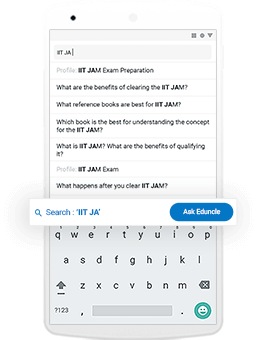Time management is very much important in IIT JAM. The eduncle test series for IIT JAM Mathematical Statistics helped me a lot in this portion. I am very thankful to the test series I bought from eduncle.
Nilanjan Bhowmick AIR 3, CSIR NET (Earth Science)Shib Sagar posted an Question
- IIT JAM
- Chemistry (CY)
Give the structure of the option and explain
Uny LUvaicn COVRicnt &Cou Which of the following molecules d
- 0 Likes
- 4 Comments
- 0 Shares
-
Suman Kumar Best Answer
Option D is correct
![eduncle-logo-app]()
See this Shib
![eduncle-logo-app]()
All three have co-ordinate bond
![eduncle-logo-app]()
But CO3 ²- doesn't have co-ordinate bond
![eduncle-logo-app]()
please ask if you don't get anything 🙏
![eduncle-logo-app]()
sir in the structure ch3ch we know that coordinate bond is only given to oxygen atom because oxygen wants 2 electrons to complete octate but u r giving coordinate bond to carbon how is this possible
![eduncle-logo-app]()
Draw Lewis structure Shib
![eduncle-logo-app]()
See this
-
![comment-profile-img]() >
>
Priyanshu kumar
carbonate ion CO32- doesnt have coordinate bond
![eduncle-logo-app]()
see this shib
![eduncle-logo-app]()
got it shib??
![eduncle-logo-app]()
sir pz explain ch3cn
![eduncle-logo-app]()
see shib...when you draw lewis dot structure then you clearly got it...if problem then count the Total V.E...then also it easier
![eduncle-logo-app]()
got it shib??
Do You Want Better RANK in Your Exam?
Start Your Preparations with Eduncle’s FREE Study Material
- Updated Syllabus, Paper Pattern & Full Exam Details
- Sample Theory of Most Important Topic
- Model Test Paper with Detailed Solutions
- Last 5 Years Question Papers & Answers
Sign Up to Download FREE Study Material Worth Rs. 500/-










 >
>


 >
>







Suman Kumar![best-answer]()
You said correct Shib oxygen needs 2 eletron so it can form coordinate bond.
But like oxygen there are many which needs 2 eletron
For H+ needs 2 eletron.
CH3 + needs 2 eletron.
Got it Shib
BF3 also needs 2 eletron so it can also form coordinate bond
Got it Shib 🙏